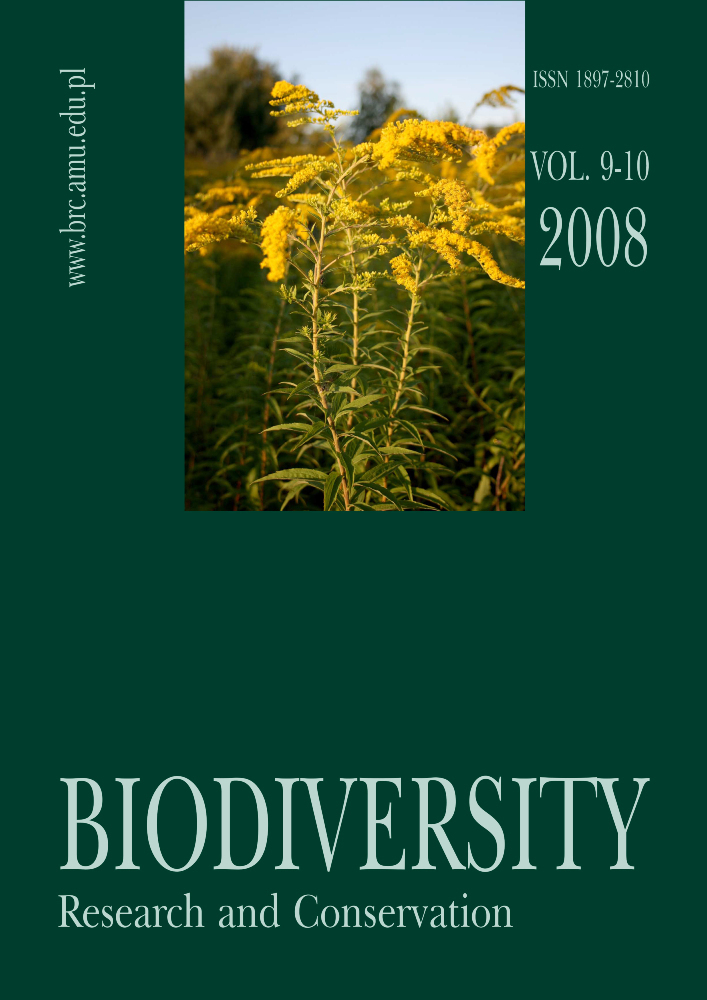Abstract
Central Poland is a region with low wetland richness. Its most valuable meadows and peatlands are situated in the eastern part of the Warsaw-Berlin proglacial valley, between Łowicz and Dąbie. This largest wetland area of Central Poland covers ca. 20 000 hectares, with a mosaic of meadows, forests, various wetlands, and small areas of arable land. Over the last 50 years, a negative impact of agriculture has been observed in the plant cover at the bottom of the proglacial valley, e.g. extinction of many wetland plant species. The main aim of this research was to determine the impact of agriculture on floristic diversity and natural condition of the wetland. In the 77 studied squares (1 km2each), we recorded ca. 600 species of vascular plants. The squares greatly varied in species composition and number. The long-term human pressure on the proglacial valley flora caused its significant degradation: with the progress of transformation of the area, the participation of anthropophytes and apophytes increases. Additionally, intensive agriculture in the proglacial valley causes extinction of species from wetland habitats.
References
AMEZAGA J. M., SANTAMARIA M. & GREEN A. J. 2002. Biotic wetland connectivity-supporting a new approach for wetland policy. Acta Oecologica 23: 213-222. DOI: https://doi.org/10.1016/S1146-609X(02)01152-9
CELKA Z. 1999. Rośliny naczyniowe grodzisk Wielkopolski. Prace Zakładu Taksonomii Roślin UAM w Poznaniu 9: 1-159. Bogucki Wyd. Nauk., Poznań.
CHMIEL J. 1993. Flora roślin naczyniowych wschodniej części Pojezierza Gnieźnieńskiego i jej antropogeniczne przeobrażenia w wieku XIX i XX, cz. 1 i 2. Prace Zakładu Taksonomii Roślin UAM w Poznaniu 1; 1: 1-202, 2: 1-212. Wyd. Sorus, Poznań.
CHMIEL J. 2006. Zróżnicowanie przestrzenne flory jako podstawa ochrony przyrody w krajobrazie rolniczym. Prace Zakładu Taksonomii Roślin UAM w Poznaniu 14: 1-250. Bogucki Wyd. Nauk., Poznań.
DAHL T. E. 1990. Wetlands losses in the United States 1780’s to 1980’s. 13 pp. D.C. US Department of the Interior, Fish and Wildlife Service, Washington.
FAIZI S. & Al-WETAID J. 1997. Regional priorities for wetlands conservation in West Asia and North Africa. Natural Resources Forum 21(1): 69-71. DOI: https://doi.org/10.1111/j.1477-8947.1997.tb00674.x
FINLAYSON C. M. & REA N. 1999. Reasons for the loss and degradation of Australian wetlands. Wetlands Ecology and Management 7: 1-11. DOI: https://doi.org/10.1023/A:1008495619951
FINLAYSON C. M., STORRS M. J. & LINDNER G. 1997. Degradation and rehabilitation of wetlands in the Alligator Rivers Region of northern Australia. Wetlands Ecology and Management 5: 19-36. DOI: https://doi.org/10.1023/A:1008271219441
GUZIAK R. & LUBACZEWSKA S. 2001. Ochrona przyrody w praktyce. Podmokłe łąki i pastwiska. 150 pp. Polskie Towarzystwo Przyjaciół Przyrody „pro Natura”, Wrocław.
HARTIG E. K., GROZEV O. & ROSENZWEIG C. 1997. Climate change, agriculture and wetlands in Eastern Europe: vulnerability, adaptation, policy. Climatic Change 36: 107-121. DOI: https://doi.org/10.1023/A:1005304816660
JONES T. A. & HUGHES J. M. R. 1993. Wetland inventories and wetland loss studies: a European perspective. In: M. MOSER, P. PRENTICE & J. VAN VESSEM (eds.). Waterfowl and Wetland Conservation in the 1990’s: A Global Perspective. Pvoc. IWRB Symp. St. Petersburg Beach, Florida, USA. IWRB Spec. Publ. No 26, Slimbvidge, UK. 164-169.
JACKOWIAK B. 1990. Antropogeniczne przemiany flory roślin naczyniowych Poznania. Wyd. Nauk. UAM, seria Biologia, 42, 232 pp. Poznań.
JACKOWIAK B. 1998. The hemeroby concept in the evaluation of human influence on the urban flora of Vienna. In: J. B. FALIŃSKI, W. ADAMOWSKI & B. JACKOWIAK (eds.). Synantropization of plant cover in new Polish research. Phytocoenosis 10 (N.S.) Suppl. Cartogr. Geobot. 9: 79-96.
JACKOWIAK B. 2006. Methodological proposals for studies on the structure and dynamics of urban flora. Polish Botanical Studies 22: 251-260.
KOPEĆ D., CHMIELECKI B., HALLADIN-DĄBROWSKA A., WYLAZŁOWSKA J., KOZACZUK A., POPKIEWICZ P., TRAUTSELIGA A. & KUCHARSKI L. 2009. Pradolina Warszawsko-Berlińska – ostoją cennych gatunków roślin naczyniowych. Parki Nar. Rez. Przyr. 28(2): 97-106.
KORNAŚ J. 1981. Oddziaływanie człowieka na florę: mechanizmy i konsekwencje. Wiad. Bot. 25(3): 165-182.
KORNAŚ J. & MEDWECKA-KORNAŚ A. 2002. Geografia roślin, wyd. 2, 634 pp. Wyd. Nauk. PWN, Warszawa.
KUCHARSKI L. 1994. Wpływ melioracji na szatę roślinną solnisk w okolicy Łęczycy (pradolina warszawsko-berlińska). Zesz. Nauk. AR we Wrocławiu, 248, Konferencje 3(1): 93-98.
KUCHARSKI L. & PISAREK W. 2001. Roślinność terenów podmokłych w Polsce Środkowej i jej ochrona. Chrońmy Przyr. Ojcz. 57(5): 33-54.
LINDACHER R. (ed.). 1995. Phanart Databank der Gafässpflanzen Mitteleuropas, Erklärung der Kennzahlen, Aufbau und Inhalt (Phanart, Database of Centraleuropean Vascular Plant,Explanation of Codes, Structure and Contans). Veröffentlichungen Geobotanischen Insitut der ETH Stifung Rübel, 125. Zürich. Strony
MĄDALSKI J. 1954. Nowe stanowiska halofitów i innych roślin w okolicach Łęczycy. Fragm. Flor. Geobot. 1(2): 69-80.
MOWSZOWICZ J. 1964. Interesujące rośliny w Łęczyckiem. Ziemia łęczycka. In: J. GRODZKA (eds.). Szkice o teraźniejszości i przeszłości, pp. 21-38. Muzeum w Łęczycy, Wydawnictwa Łódzkie, Łódź.
OLACZEK R. 1974. Materiały do flory Polski Środkowej. Zesz. Nauk. UŁ. ser. II, 54: 27-39.
PLIT J. 1996. Antropogeniczne i naturalne przeobrażenia krajobrazów roślinnych Mazowsza (od schyłku XVIII w. do 1990 r.). Prace Geograf. 166: 1-135.
RATYŃSKA H. 2003. Szata roślinna jako wyraz antropogenicznych przekształceń krajobrazu na przykładzie zlewni rzeki Głównej (środkowa Wielkopolska). 392 pp. Wyd. Akademii Bydgoskiej im. K. Wielkiego, Bydgoszcz.
SCHUYT K. D. 2005. Economic consequences of wetland degradation for local populations in Africa. Ecological Economics 53: 177-190. DOI: https://doi.org/10.1016/j.ecolecon.2004.08.003
STATSOFT, INC. 2003. STATISTICA (data analysis software system), version 6. www.statsoft.com.
SUTHERLAND W. J. 1998. Conservation science and action. 364 pp. Blackewell Publishing. DOI: https://doi.org/10.1002/9781444313499
SZAFER W. 1977. Szata roślinna Polski niżowej. In: W. SZAFER & K. ZARZYCKI (eds.). Szata roślinna Polski, II, wyd. 3, 17-188. PWN, Warszawa.
WHIGHAM D. F. 1999. Ecological issues related to wetland preservation, restoration, cration and assessment. The Science of the Total Environment 240: 31-40. DOI: https://doi.org/10.1016/S0048-9697(99)00321-6
WINNIECKI A., KUCHARSKI L. & WOJCIECHOWSKI Z. 1989. Dokumentacja przyrodnicza dla rezerwatu „Błonie” (w rozszerzonych granicach). Manuskrypt, „Ekoplan”, Łódź-Poznań-Warszawa.
VAN DER MAAREL W. 1971. Florastatistieken als bijdrage tot de evaluatie van natuurgebieden. Gorteria 5: 176-188.
ZHAO K. & E CH. 2001. The wetland types, functions and conservation in China. Chinese Geographical Science 11(4): 300-305. DOI: https://doi.org/10.1007/s11769-001-0044-y
License
Copyright © by Adam Mickiewicz University, Poznań, Poland, Department of Plant Taxonomy, 2008OPEN ACCESS




